Introduction
In the rapidly evolving landscape of data analytics, the integration of SQL Server Analysis Services (SSAS) with Power BI emerges as a game-changer for organizations striving to enhance their Business Intelligence capabilities. By leveraging SSAS, businesses can build sophisticated multidimensional data models that not only streamline the reporting process but also address critical challenges such as data inconsistencies and inefficiencies in report creation.
This article delves into the intricacies of connecting Power BI with SSAS, providing a comprehensive step-by-step guide, troubleshooting tips for common issues, and best practices to optimize performance. Additionally, it explores advanced features that can unlock deeper insights and drive operational efficiency.
As organizations seek to transform raw data into actionable insights, understanding how to effectively harness these powerful tools is essential for fostering growth and maintaining a competitive edge in today’s data-driven world.
Understanding SQL Server Analysis Services and Its Role in Power BI
The sql server analysis services power bi functions as a key element of the Microsoft SQL Server suite, enabling users to create and oversee advanced multidimensional constructs vital for effective Business Intelligence. Its integration with Business Intelligence is crucial in addressing issues like lengthy report generation and inconsistencies, as the analytical services offer a strong backend source capable of managing complex analytical queries and intricate aggregations. By creating a link between BI and sql server analysis services power bi, users can utilize the extensive models and advanced computations developed within sql server analysis services power bi, significantly improving their reporting and visualization abilities.
Comprehending the arrangement of information into cubes and dimensions within SSAS is essential, as this structure directly affects accessibility and analysis in BI. This knowledge not only facilitates a more effective transformation of raw information into actionable insights but also positions users to fully leverage their analytical efforts. In today’s data-driven landscape, the lack of actionable insights can hinder growth, making it imperative for businesses to adopt these tools.
Furthermore, outdated systems can exacerbate these issues, but RPA solutions, such as EMMA RPA, can streamline processes and enhance operational efficiency. With Power BI services like the 3-Day Sprint for rapid report creation and the General Management App for comprehensive management, businesses can transform operations and drive growth. A key statistic to consider is that the fourth round with a sampling rate of 30% successfully removed all non-compliant steps, highlighting the importance of accuracy and maintenance.
As noted by Adrien Muhlemann, a database performance engineer at Ivalua, ‘Finally, I hope that you found this article interesting, and that you have learned something!’ This statement acts as an encouragement to engage with these powerful tools for enhanced analysis. Furthermore, the case study titled ‘Tuning Phase of Statistics Improvement‘ illustrates how updating statistics with larger sampling rates can enhance accuracy while minimizing resource expenditure, providing a practical example of its impact in real-world scenarios.
To learn more about how these tools can benefit your organization, consider booking a consultation.
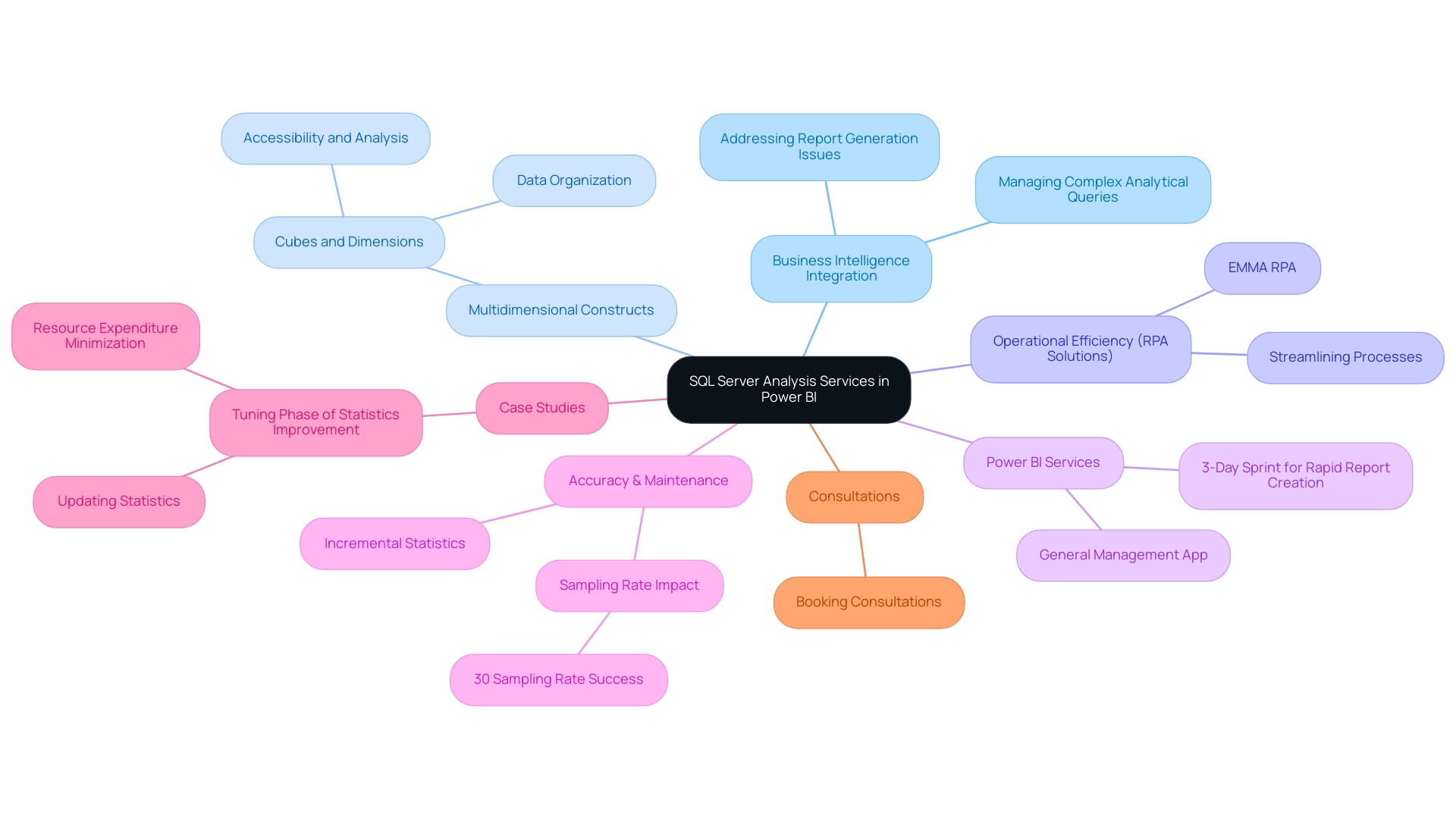
Step-by-Step Guide to Connecting Power BI with SQL Server Analysis Services
Linking BI to SQL Server Analysis Services
Power BI creates a realm of visualization and analysis opportunities that are essential for utilizing Business Intelligence to enhance operational efficiency. This tool not only offers efficient information compression—1GB can signify roughly 50 million rows—but also converts raw information into actionable insights, enabling your organization to make informed, evidence-based decisions. Moreover, integrating Robotic Process Automation (RPA) solutions can further streamline the report creation process, reducing the time spent on repetitive tasks and minimizing data inconsistencies.
Follow these steps to establish a seamless connection:
- Open BI Desktop: Begin by launching BI Desktop on your workstation.
Get Data: Navigate to the ‘Home’ tab and select ‘Get Data’. - From the dropdown menu, choose ‘SQL Server Analysis Services Database’.
- Enter Server Details: In the dialog box that appears, input the server name hosting your Analysis Services. If applicable, specify the database name you wish to connect to.
- Select Connection Mode: You’ll have the option to choose between ‘Import’ or ‘DirectQuery’ mode. Import mode enables you to load information into Power BI, while DirectQuery offers a live link to your analysis services.
Authenticate: Click ‘OK’ and enter your credentials when prompted.
Ensure you possess the necessary permissions to access the SSAS database; this is crucial for a successful connection. You can confirm this by accessing files, options and settings, and settings to replace your source if necessary.
- Select Information Structures: After connecting, a navigator pane will show the available information frameworks.
Select the model(s) you wish to work with in Business Intelligence. - Load Information: Click ‘Load’ to import the chosen information into BI. If you chose DirectQuery, the information will be queried live as you create your reports.
Generate Reports: With the information now loaded, utilize BI’s visualization tools to design insightful reports and dashboards based on your analytical services.
Additionally, it’s important to comprehend how user permissions are validated in this context. In a case study involving roles in the Local Active Directory Instance, Analysis Services converts the effective user name from Microsoft Entra ID to the local Active Directory, helping validate user permissions and ensure proper access control.
By adhering to these steps and considering these insights, including the integration of RPA for automating report generation, you can effectively connect BI to SQL Server Analysis Services Power BI, unlocking powerful data analysis and visualization capabilities that enhance your operational efficiency.
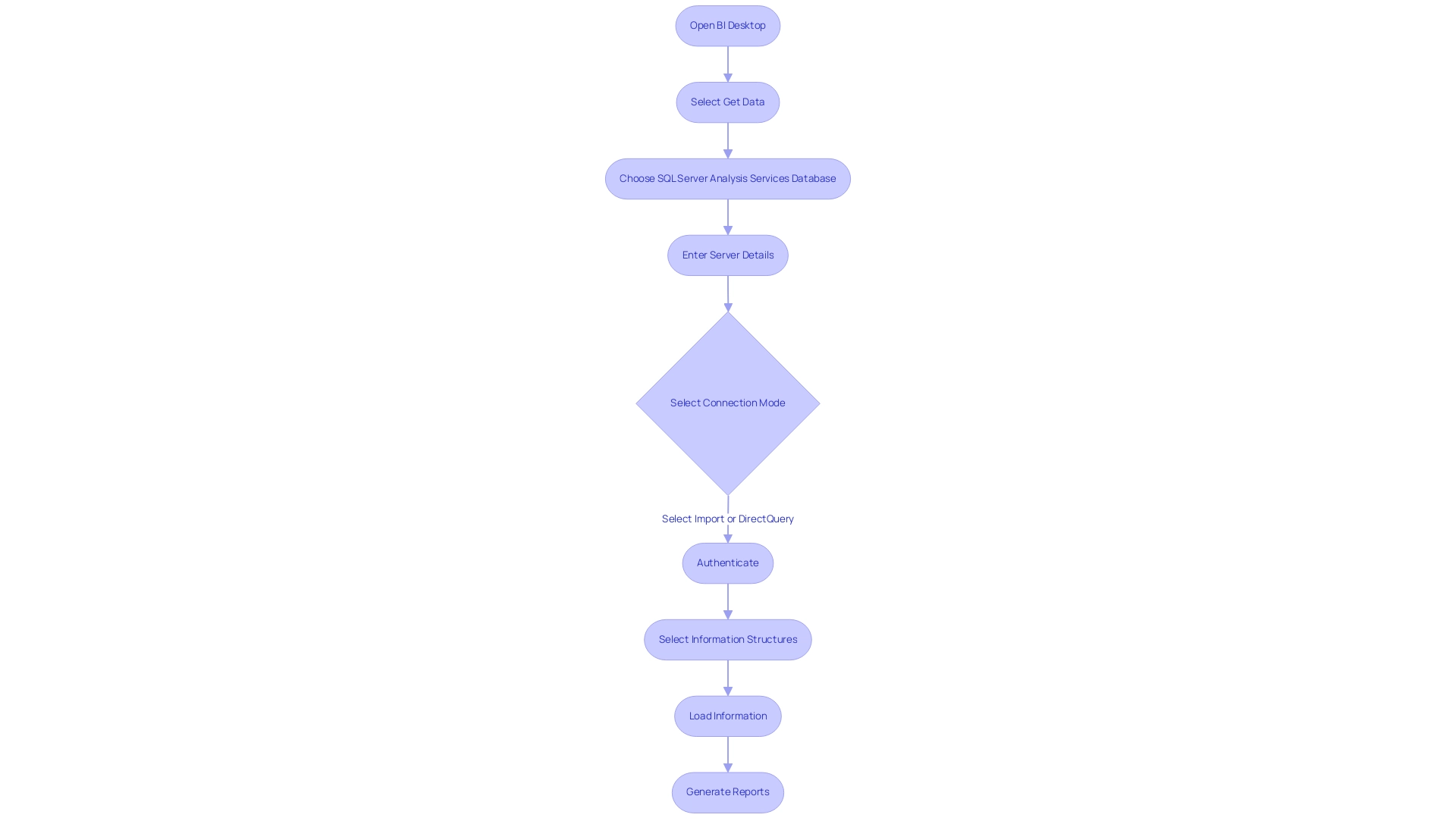
Common Issues and Troubleshooting Tips
Connecting Power BI to SQL Server Analysis Services
Power BI is typically a straightforward process; however, users often encounter common challenges that can hinder their efficiency. Here are key troubleshooting tips designed to empower you in overcoming these obstacles:
-
Connection Timeout: If you experience a connection timeout, first verify that the analysis services server is operational and reachable within your network. Review firewall settings and ensure that the appropriate port is open to facilitate communication, thus streamlining your workflow. Implementing Robotic Process Automation (RPA) can further enhance this process by automating routine checks and alerts related to connectivity issues.
-
Authentication Errors: When faced with authentication issues, meticulously review your credentials and ensure that you possess the necessary permissions for accessing the database. Confirm that you are utilizing the correct authentication method, whether it’s Windows authentication or SQL Server authentication, to prevent unnecessary delays in accessing critical information. Customized AI solutions can help by examining authentication trends and recommending ideal access techniques based on your usage history.
-
Information Structure Not Visible: If the expected information structures do not show in the navigator pane, confirm that the analysis services database is correctly set up and that you possess the necessary access to the particular structures. Refreshing the connection or restarting Power BI can rectify visibility issues, allowing for smoother information analysis and reporting. RPA can automate the refresh procedure, ensuring that model information is consistently updated without manual intervention.
-
Performance Issues: When facing slow performance, consider optimizing your analytical models by minimizing the number of columns and rows and adjusting information aggregation settings. Utilizing DirectQuery can greatly impact performance; hence, assess whether transitioning to Import mode aligns better with your retrieval requirements, improving overall efficiency. Utilizing AI solutions can offer insights into performance bottlenecks and suggest modifications to enhance data retrieval speed.
By proactively tackling these frequent issues with the offered solutions, you can greatly improve your connection process and ensure smoother interactions with SQL Server Analysis Services Power BI. Keep in mind the evolving landscape of analytics tools—architecting solutions with future transitions to Premium Capacity in mind will position your organization for success. For those interested in enhancing their skills, use code MSCUST for a $150 discount for the Microsoft Fabric Community Conference.
Moreover, as noted by an industry expert, romanovmv:
I’ve figured out why that happened: there was a setting discourage Implicit Measures set to be true in the on-premises Tabular structure. Should have probably turned it on while experimenting with calculation groups. Problem is solved now.
For practical insights, consider the case study titled ‘Resolving Connection Issues with Azure Analysis Services,’ where a user faced a new error related to Azure Analysis Services and the Data Gateway connecting to an Oracle database.
This example illustrates the importance of checking specific error messages and seeking expert assistance when necessary. Lastly, remember the value of community support; as highlighted by Gilbert, marking posts as solutions can greatly aid others in troubleshooting effectively, ensuring that your team can focus on strategic, value-adding work.
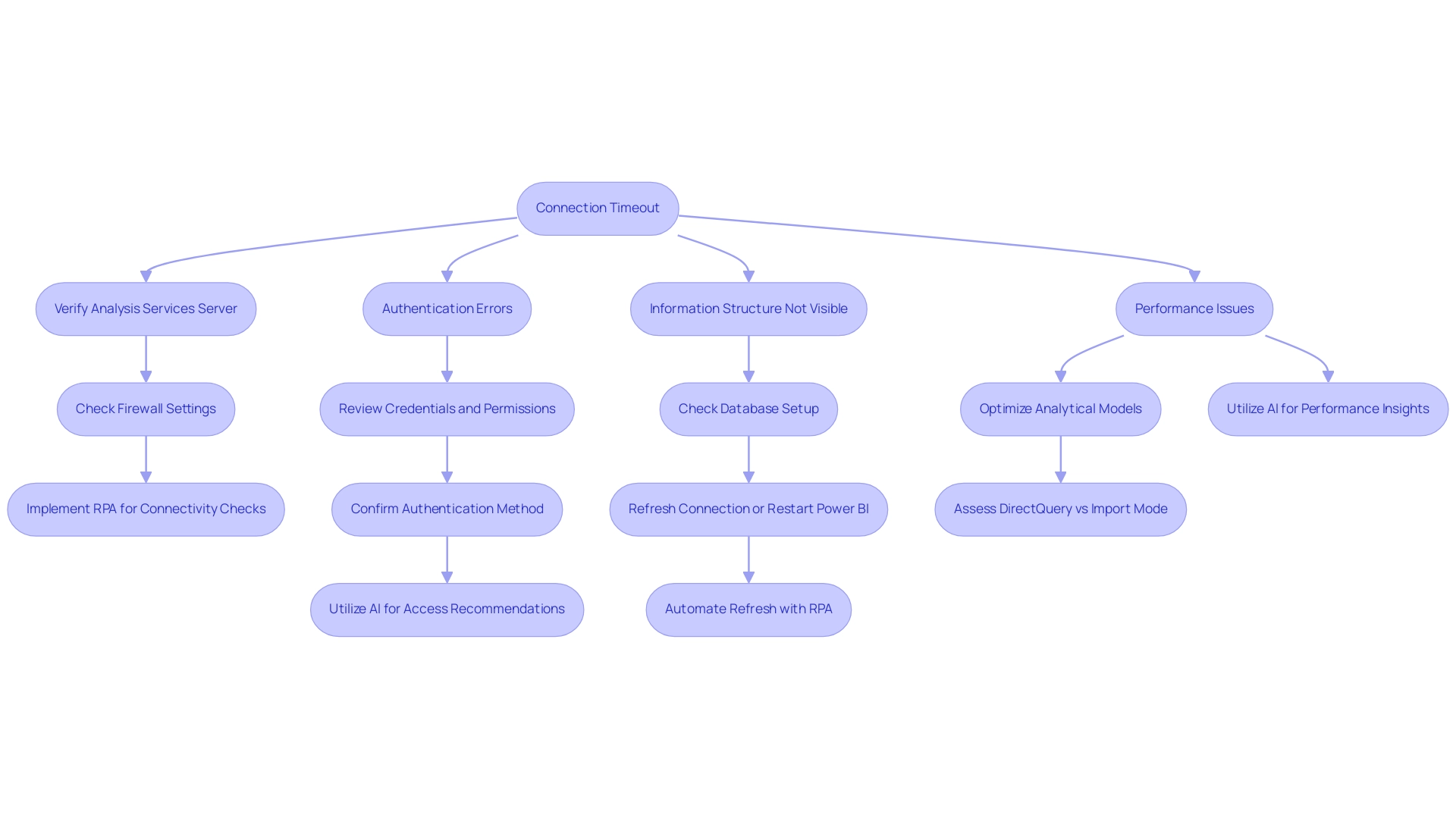
Best Practices for Using SSAS with Power BI
To fully harness the potential of Power BI when connected with SQL Server Analysis Services (SSAS), it is essential to adopt several best practices that enhance performance and user experience while addressing common technology implementation challenges:
-
Enhance Information Structures: Arrange your SSAS information frameworks carefully to guarantee optimal performance. This involves eliminating unnecessary columns and streamlining calculations, which can significantly reduce processing time and improve report responsiveness. As Prabu Chandran aptly notes, “the query provides only active session details,” emphasizing the significance of accurate information management in this process. By refining information structures, organizations can alleviate problems associated with inadequate master quality, improving the precision of insights obtained from BI.
-
Leverage Hierarchies: Implement hierarchies within your SSAS models to simplify information navigation. By enabling users to drill down seamlessly into information through SQL Server Analysis Services Power BI, you enhance their experience in Power BI, minimizing confusion and maximizing efficiency. This approach is essential in overcoming the challenges related to time-consuming report creation and inconsistencies.
-
Implement Row-Level Security: For organizations that prioritize information security, establishing row-level security within SSAS is crucial. This practice manages access to sensitive information based on user roles, ensuring that individuals only view what they are authorized to see. This not only safeguards integrity but also fosters trust in the insights produced.
-
Schedule Regular Information Refreshes: Keeping your analytical frameworks current is essential for ensuring accuracy in Business Intelligence. Automate refresh schedules to guarantee that reports reflect the latest information, thereby supporting informed decision-making. Regular updates are essential in a data-rich environment where timely insights can provide a competitive edge. This practice can also be enhanced by integrating Robotic Process Automation (RPA) to streamline the refresh process, ensuring efficiency and accuracy.
-
Monitor Performance Continuously: Regularly assess the performance metrics of your SQL Server Analysis Services Power BI reports and models. This proactive approach enables you to identify potential bottlenecks and make necessary adjustments, ensuring that users have an optimal experience. Monitoring performance is essential in addressing the obstacles to successful AI integration and maximizing the value obtained from information. Customized AI solutions can aid in analyzing performance information, offering actionable insights to enhance processes further.
Furthermore, real-world case studies, such as user-friendly perspectives, demonstrate how optimized SSAS frameworks can enhance accessibility. By creating ‘perspectives‘ to hide irrelevant portions of the model, organizations can enhance user experience, allowing users to focus on relevant information without distraction. By adhering to these best practices, organizations can significantly enhance their operational efficiency and the overall effectiveness of their BI implementations.
Moreover, although handling files in OneLake programmatically with the Python Azure SDK may not directly connect to analytical services best practices, grasping this capability can offer further context for enhancing workflows.
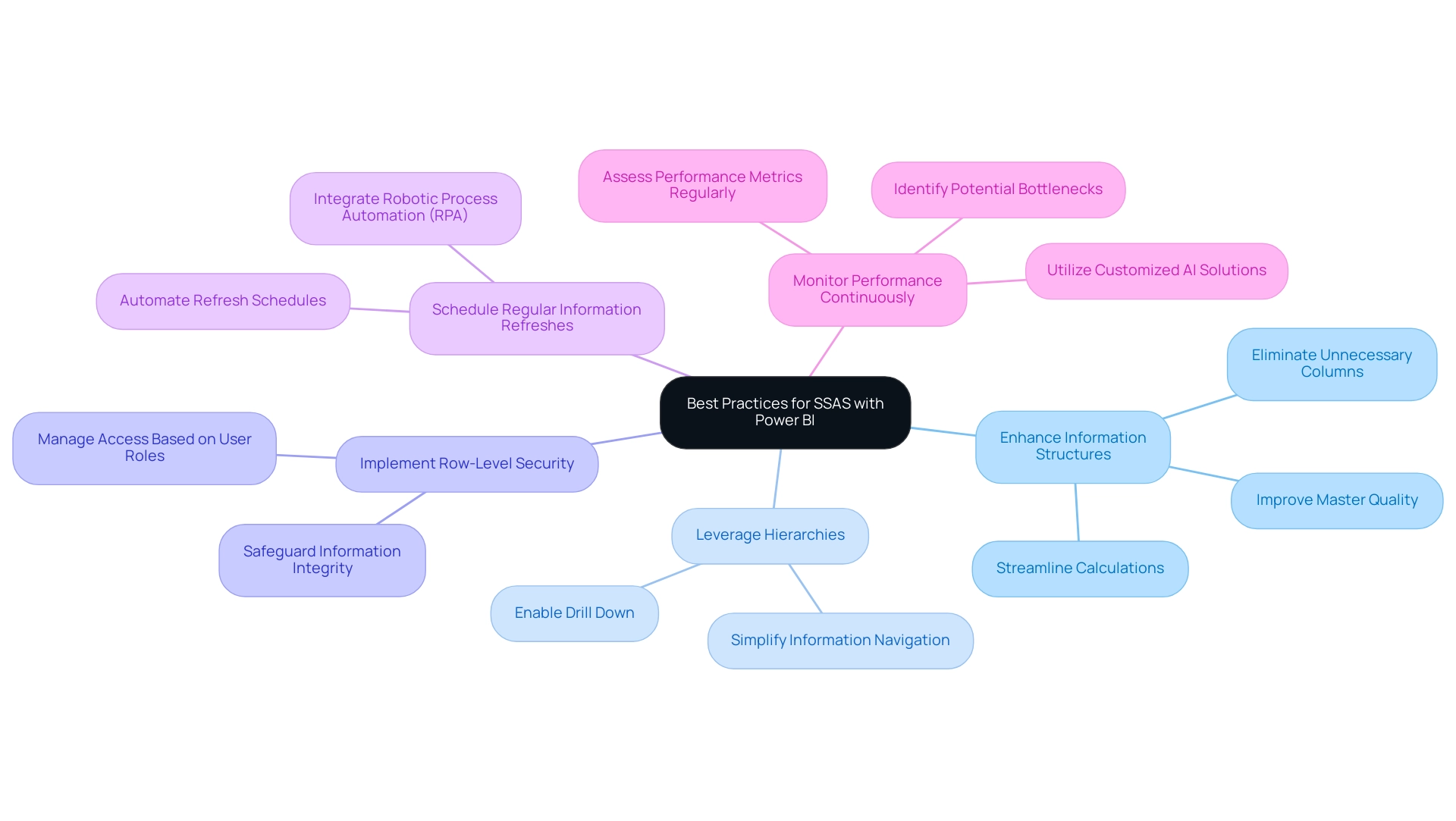
Exploring Advanced Features of SSAS in Power BI
After successfully establishing a connection between Power BI and SQL Server Analysis Services, it’s essential to explore several advanced features that can significantly enhance your analytical capabilities while also considering the role of Robotic Process Automation (RPA) in streamlining manual workflows:
-
Calculated Measures: By utilizing calculated measures within the system, you can create custom calculations tailored to your specific business requirements. This flexibility permits comprehensive insights that closely correspond with your operational goals, ultimately improving efficiency in handling information and reporting while decreasing the manual effort required in producing these insights.
-
Data Mining Models: If your analytical services instance supports data mining, dive into these models to uncover hidden patterns and trends in your information. Incorporating these insights into Power BI not only enriches your reports but also improves decision-making processes throughout the organization, facilitating the identification of opportunities for automation through RPA, which can help relieve the burden of repetitive analysis tasks. Mastering Multi-dimensional Expressions (MDX) for querying and manipulating information in SQL Server Analysis Services Power BI can provide profound insights and enable complex calculations that surpass what standard SQL queries offer. This capability is crucial for generating detailed reports that inform strategic initiatives, helping to pinpoint areas where RPA can further improve operational efficiency by automating the report generation process.
-
Integration with Azure Analysis Services: Leverage Azure Analysis Services for cloud-based analytics, which offers scalability and improved performance, particularly for organizations managing large datasets. This integration ensures that your analytics processes remain robust and responsive to changing information demands, supporting the efficient automation of workflows through RPA, thereby reducing the time spent on manual management tasks.
-
Custom Visuals in Business Intelligence: Discover the application of custom visuals to depict analytics information in creative manners. Custom visuals not only enhance user engagement but also facilitate a deeper understanding of the information, making it easier to convey insights to stakeholders and driving the adoption of analytics-driven decision-making across your organization.
Moreover, due to effective information compression, a rough basis for estimation would be 50 million rows in 1GB, showcasing the efficiency of handling when using SQL Server Analysis Services Power BI. Engaging with these advanced features empowers users to unlock the full potential of their analysis, fostering innovation and informed decision-making in their organizations. As noted by one user, mchapman, understanding usage statistics is crucial: ‘Thanks for the reply, I will include that trace log as part of my usage statistics… This should assist in determining if what’s being delivered is what was needed.’ Therefore, incorporating these advanced techniques with RPA will not only streamline operations but also guarantee that the information provided aligns with managerial expectations. Additionally, consider the case study on changing the data source from SQL Server to Power BI datasets, which illustrates a practical application of transitioning data sources while maintaining existing reports and visuals, highlighting how RPA can facilitate this process by automating data source updates and ensuring consistency across reports.
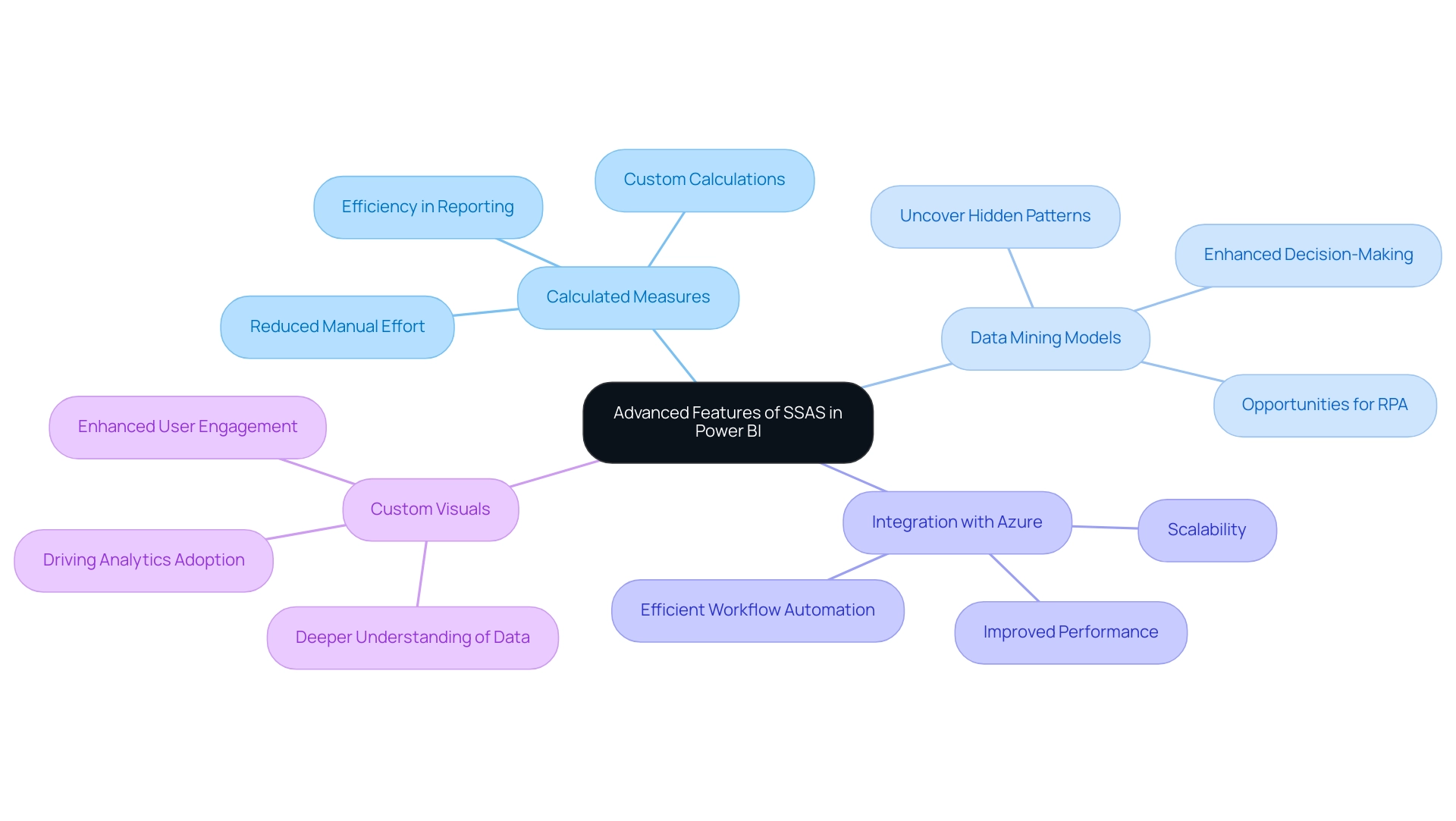
Conclusion
Harnessing the power of SQL Server Analysis Services (SSAS) in conjunction with Power BI can transform the way organizations approach data analytics and reporting. By establishing a seamless connection between these two powerful tools, businesses can create sophisticated multidimensional data models that address common challenges such as data inconsistencies and inefficiencies in report generation. This integration not only streamlines the data analysis process but also enhances the overall quality of insights derived, ultimately driving operational efficiency.
Throughout this article, critical steps for connecting Power BI with SSAS were outlined, including troubleshooting tips and best practices to optimize performance. Emphasizing the importance of data model optimization, implementing hierarchies, and maintaining data security through row-level access reinforces the necessity of a strategic approach to data management. Additionally, exploring advanced features such as calculated measures and data mining models can further empower organizations to uncover deeper insights and automate repetitive processes, maximizing the value of their data analytics efforts.
As the demand for actionable insights continues to grow in today’s data-driven landscape, leveraging the capabilities of SSAS alongside Power BI is essential for fostering growth and maintaining a competitive edge. By investing in these tools and following the best practices discussed, organizations can not only enhance their reporting capabilities but also cultivate a culture of informed decision-making that propels them toward success in their respective industries. Now is the time to embrace these solutions and unlock the full potential of data analytics for a more efficient and insightful future.

